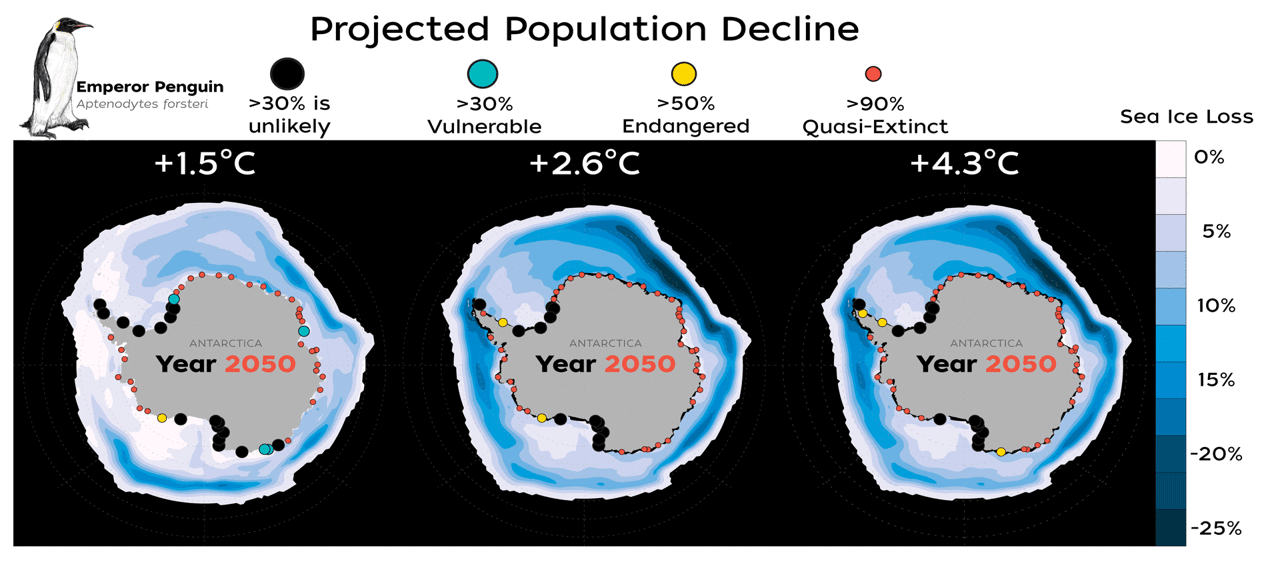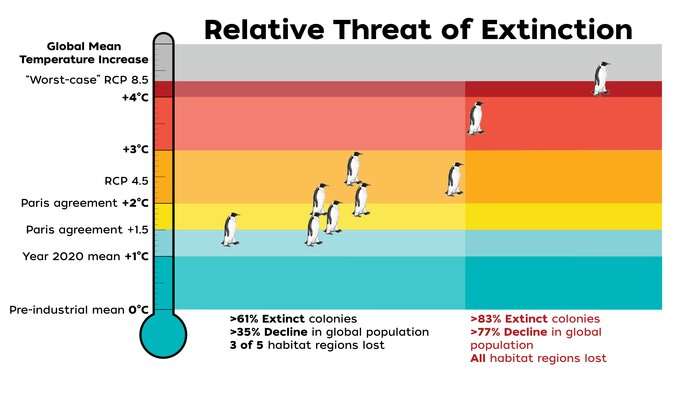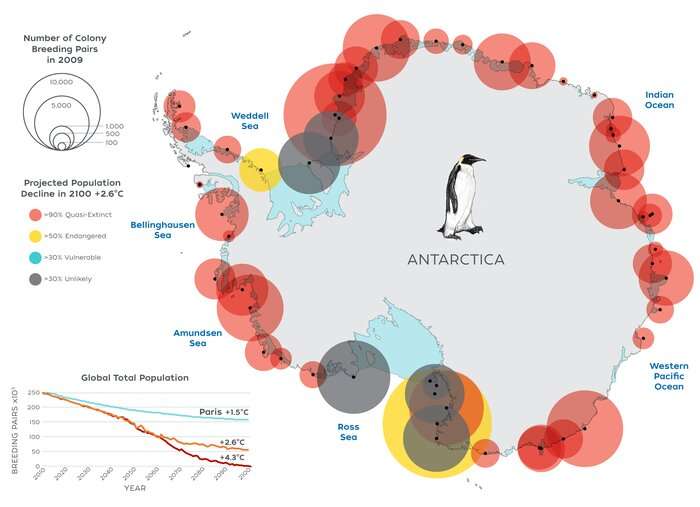New study finds emperor penguins increasingly threatened by climate change

A new study published today in Global Change Biology provides valuable new data that highlights how species extinction risk is accelerating due to rapid climate change and an increase in extreme climate events, such as glacial calving and sea ice loss. The study, led by Stephanie Jenouvrier, associate scientist, and seabird ecologist at Woods Hole Oceanographic Institution, and co-authored by an international team of scientists, policy experts, ecologists, and climate scientists, provided pivotal research and projections tailored for use by the U.S Fish & Wildlife Service (USFWS). Their work proposed that emperor penguins be listed as threatened under the Endangered Species Act and this week, USFWS submitted that listing proposal.
"Scientists have a responsibility to make people aware of the need for change through objective evidence," explained Jenouvrier. "With the help of a dedicated team, we put together this paper for the USFWS to provide additional analyses of future projections and help inform policy and protection for the species."
The study presents the projected dynamics of all known emperor penguin colonies under different greenhouse gas emission scenarios using a climate‐dependent meta-population model that includes for the first time, the effects of extreme climate events based on the observational satellite record of colonies.
According to co-author Shaye Wolf, Climate Science Director at the Center for Biological Diversity, "Protection of species through legal frameworks should facilitate conservation actions that in turn should help mitigate climate change impacts." Co-author Judy Che-Castaldo of the Lincoln Park Zoo added, "The study is framed in the context of the U.S Endangered Species Act, one of the most progressive pieces of legislation in relation to species protection."
The study demonstrates that extreme events impact the resiliency, redundancy, and representation (3Rs) of emperor penguins. Resiliency is the ability to withstand stochastic (or random) disturbance, which may be measured through population size, growth rate, and connectivity among populations. Redundancy is the ability to withstand catastrophic events, and considers the number, distribution, resiliency, and connectivity of populations. Representation is the ability to adapt to changing environmental conditions, and is related to capturing the geographic, genetic, and life history variation that exists across the species' ecological setting. Together, the 3Rs encompass aspects that contribute to species persistence (e.g., demography, spatial distribution, diversity) and are important for assessing climate threats in the foreseeable future. The study shows that if sea ice declines at the rate projected by climate models under current energy-system trends and policies, the 3Rs would be dramatically reduced and almost all colonies would become quasi-extinct by 2100.

The novel results described in the paper also have important implications for assessing climate change risks to other species. According to the authors, rapid climate change is increasing stress on species and ecosystems, and the risk of extinction will accelerate with continued global warming. Emperor penguins live in the icy coastal regions of Antarctica, but current climate models project significant declines in Antarctic Sea ice to which the emperor penguins' life cycle is closely tied. The study reinforces the need for legal recognition and enhanced precautionary management, particularly given continued increases in greenhouse gas emissions.
"Emperor penguins live in a delicate balance with their environment, there is a sea ice 'Goldilocks' zone", said Jenouvrier. "If there is too little sea ice, chicks can drown when sea ice breaks up early; if there is too much sea ice, foraging trips become too long and more arduous, and the chicks may starve."
"Given the species' reliance upon sea ice for breeding, molting, and feeding, the most important threat for emperor penguins is climate change, which would lead to Antarctic Sea ice losses over this century," explained Marika Holland a climate scientist with the National Center for Atmospheric Research. "Trends in warming and consequential sea ice losses through the end of the century are clear and unidirectional under all projections from all climate models."
Christophe Barbraud, from the Centre d'Etudes Biologiques de Chizé, has been studying emperor penguins for decades, and added, "The long-term monitoring of emperor penguins at Pointe Géologie, Antarctica, over the past 70 years was critical to decipher how sea ice affects the bird's life cycle. This knowledge, together with recent satellite imagery, provided necessary information to build and validate population models."
"The high-resolution satellite images provided critical remote access to places we'd never be able to see otherwise. As it turns out, sometimes colonies 'blink', seemingly because of drastic changes in the environment that we are still working to solve," added Michelle LaRue of the Department of Earth and Environmental Sciences, University of Minnesota.

Extreme events, as observed through the satellite records, amplify the projected declines by previous studies. If greenhouse gas emissions continue to rise at levels similar to today—causing temperatures to rise and Antarctic Sea ice to shrink—penguin population numbers will diminish slowly until about 2040, after which they would decline at a much steeper rate as sea ice coverage drops below a usable threshold, with the species being quasi -extinct as 98% colonies will have disappeared by 2100.
Phil Trathan, the head of conservation biology with the British Antarctic Survey (BAS), has studied Antarctic penguins for over 30 years. "Near-term global policy decisions under Paris Agreement objectives are intended to limit temperature increases to well below 2°C. This would ensure safe places for the emperor penguin, halting dramatic global population declines. As such, the future of emperor penguins ultimately depends upon decisions made today. The most important action is to reduce greenhouse gas emissions to limit further warming".
"We hope that global society will listen to science and meet the moment. Protecting these systems requires legal frameworks that must be appropriately founded and based on the best available scientific evidence. Building an international framework will be key, but in the meantime immediate efforts should focus on those tools already in place, such as the ESA".
The international team that carried out the study highlights how this work cuts across the boundaries of science disciplines and how interdisciplinary science is key in protecting the future of this iconic species.
"This study provides the best available science for projecting emperor penguin populations in the context of future climate change and informs policy makers about whether the emperor penguin warrants listing under the ESA," concluded Jenouvrier. "The future of this iconic species depends on immediate actions to decarbonize society and increased protections for species endangered by climate change.
More information: Stephanie Jenouvrier et al, The call of the emperor penguin: Legal responses to species threatened by climate change, Global Change Biology (2021). DOI: 10.1111/gcb.15806
Journal information: Global Change Biology
Provided by Woods Hole Oceanographic Institution



















